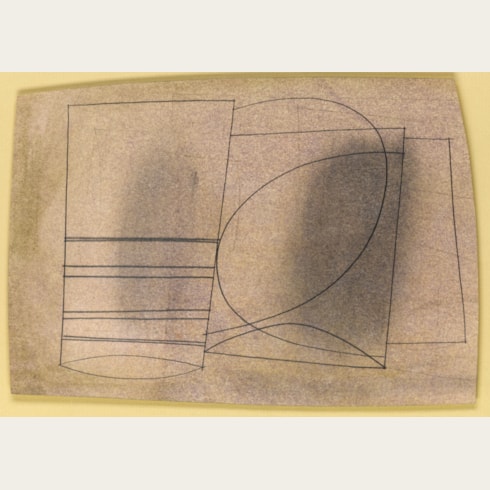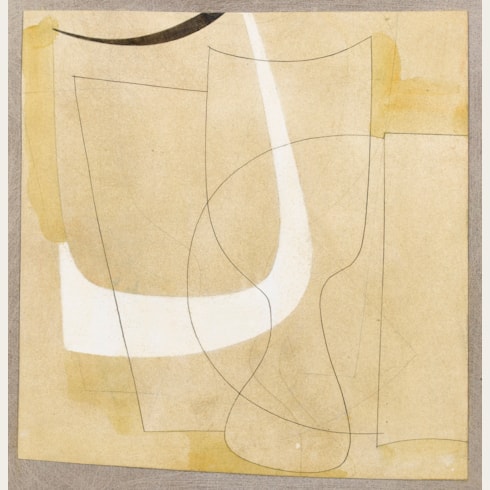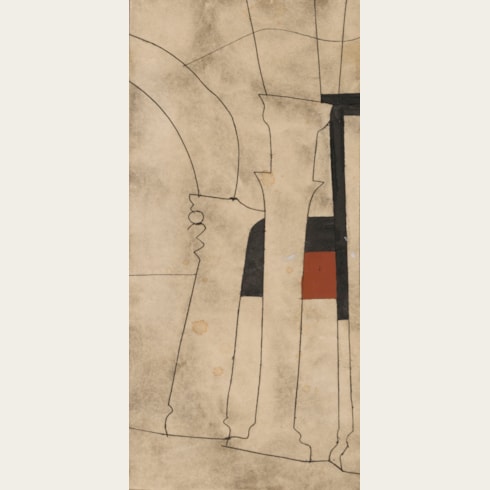Ben NICHOLSON
(Derham 1894 - London 1982)
August 27, 1954 (St. Ives)
Sold
Pencil and oil wash on paper.
Signed, dated and titled NICHOLSON / St Ives / aug 27 – 54. on the verso.
324 x 508 mm. (12 3/4 x 20 in.)
Signed, dated and titled NICHOLSON / St Ives / aug 27 – 54. on the verso.
324 x 508 mm. (12 3/4 x 20 in.)
In August 1928 Ben Nicholson made his first visit to St. Ives on the Atlantic coast of Cornwall. With only a few hours at his disposal on this day trip, he recorded as many impressions as he could in a small sketchbook. One of these drawings (now in the Ashmolean Museum in Oxford) gives a partial view of the harbour pinched between the high walls and chimneys of the crooked houses lining a steep, narrow street. The minimal lines of the architecture, though they fill most of the page, fall away to disclose the much more detailed and boldly drawn sailing boats in the harbour. Though not drawn from exactly the same spot as [this] View of St. Ives made twenty-six years later, the format, the format, the content, the idea are the same.
In August 1939 Nicholson, with his wife Barbara Hepworth and their four-year-old triplets, went to stay with Adrian Stokes and Margaret Mellis at Corbis Bay on the southern outskirts of St. Ives. When war was declared that September they decided to remain in Cornwall and soon settled in a house nearby. St. Ives was to remain Nicholson’s base for almost twenty years until he moved to Switzerland in March 1958, and the view of the harbour over a foreground of rooftops was a theme he returned to again and again in paintings and drawings of the 1940s and early 50s.
In April 1955 Nicholson moved into a small house whose terrace looked on to the very motif that had inspired him for so many years. As he wrote to Herbert Read at the time: ‘It’s an absurd place, almost as if one had made it and its surroundings oneself – v. romantic and with a whole series of different levels from which one sees between rooftops the Atlantic, the Island, St. Ives Bay, Godrevy & finally, from the topmost ‘lookout’ level, slap down into the harbour itself…Even the address is strange – Trezion, Salubrious Place.’
August 27 1954 (view of St Ives) presents us with a stark contrast between the near-abstract shapes of the blank walls and rooftops in the foreground, taking up three quarters of the picture space, and the detailed ‘nursery realism’ of the harbour below, with its tightly packed quayside buildings, its boats, pier and lighthouse, fading away to low hills in the distance. The further into the drawing one’s eye goes, the more it recognizes. The toy-town treatment of the harbour area is characteristic also of Nicholson’s Cornish landscapes of 1939-46 and has its origin in the illustrations to a projected but never published children’s book, based on stories he told his children about the adventures of two horses, George and Rufus, occasionally joined by a stag, Johnny. The faux naïf had always appealed to Nicholson’s sophisticated-childish temperament and provided one means of expressing his poetic realism.
Finally, a word about the oil wash. From the late 1940s Nicholson liked to apply a thin wash of oil paint to a part of each sheet of paper on which he intended to draw. He would select from his sheaf of prepared sheets one that seemed suitable for his chosen subject: the colour wash was something to which he would have to accommodate his drawing and so would provide a starting-off point for it as well as giving the finished work more body and personality than would a plain white background.
Peter Khoroche
September 2018
In August 1939 Nicholson, with his wife Barbara Hepworth and their four-year-old triplets, went to stay with Adrian Stokes and Margaret Mellis at Corbis Bay on the southern outskirts of St. Ives. When war was declared that September they decided to remain in Cornwall and soon settled in a house nearby. St. Ives was to remain Nicholson’s base for almost twenty years until he moved to Switzerland in March 1958, and the view of the harbour over a foreground of rooftops was a theme he returned to again and again in paintings and drawings of the 1940s and early 50s.
In April 1955 Nicholson moved into a small house whose terrace looked on to the very motif that had inspired him for so many years. As he wrote to Herbert Read at the time: ‘It’s an absurd place, almost as if one had made it and its surroundings oneself – v. romantic and with a whole series of different levels from which one sees between rooftops the Atlantic, the Island, St. Ives Bay, Godrevy & finally, from the topmost ‘lookout’ level, slap down into the harbour itself…Even the address is strange – Trezion, Salubrious Place.’
August 27 1954 (view of St Ives) presents us with a stark contrast between the near-abstract shapes of the blank walls and rooftops in the foreground, taking up three quarters of the picture space, and the detailed ‘nursery realism’ of the harbour below, with its tightly packed quayside buildings, its boats, pier and lighthouse, fading away to low hills in the distance. The further into the drawing one’s eye goes, the more it recognizes. The toy-town treatment of the harbour area is characteristic also of Nicholson’s Cornish landscapes of 1939-46 and has its origin in the illustrations to a projected but never published children’s book, based on stories he told his children about the adventures of two horses, George and Rufus, occasionally joined by a stag, Johnny. The faux naïf had always appealed to Nicholson’s sophisticated-childish temperament and provided one means of expressing his poetic realism.
Finally, a word about the oil wash. From the late 1940s Nicholson liked to apply a thin wash of oil paint to a part of each sheet of paper on which he intended to draw. He would select from his sheaf of prepared sheets one that seemed suitable for his chosen subject: the colour wash was something to which he would have to accommodate his drawing and so would provide a starting-off point for it as well as giving the finished work more body and personality than would a plain white background.
Peter Khoroche
September 2018
The son of the painters William Nicholson and Mabel Pryde, Ben Nicholson spent a brief period at the Slade School of Art in London but was otherwise without formal artistic training. It was not until 1920 and his marriage to the painter Winifred Dacre that he began to paint seriously, producing mainly still life and landscape paintings throughout the following decade. In 1932 he and his second wife, Barbara Hepworth, traveled to France and there met and befriended Pablo Picasso, Georges Braque, Constantin Brancusi and Jean Arp, and later Piet Mondrian. It was also at this time, in the 1930’s, that Nicholson began to work in a more Cubist manner, creating paintings and reliefs made up of abstract geometrical forms, and in particular producing a series of carved and painted white reliefs that have become icons of 20th century English modernism. At the outbreak of the Second World War, Nicholson and Hepworth and their children moved to the town of St. Ives in Cornwall, where they became the nucleus of a vibrant artistic community. Nicholson’s reputation grew significantly after the war, and he won several artistic prizes in America and elsewhere. In 1954 a retrospective exhibition of his work was held in the British pavilion at the Venice Biennale, followed a year later by one at the Tate. In 1958 he left St. Ives and settled in Switzerland, having annulled his marriage to Hepworth in 1951 and remarried. A second Tate retrospective in 1968 was accompanied by the awarding of the Order of Merit.
Drawing was an important part of Nicholson’s artistic process throughout his career. His drawings were, however, not made as studies for carved reliefs or paintings, and it should be noted that ‘more than simply preparatory or exploratory tools, drawings were to him full-blown works of art…His drawings are characterized by a strong continuous line, which sinuously defines form and space without a break. Shading is used sparingly and any illusion of volumetric mass simply suggested by the interweaving lines.’
Provenance
Private collection, England
Anonymous sale, London, Phillips, 15 November 1991, lot 83
Marlborough Graphics, London
Acquired from them in 1994 by a private collection, United Kingdom
Anonymous sale, London, Sotheby’s, 12 June 2018, lot 510.
Anonymous sale, London, Phillips, 15 November 1991, lot 83
Marlborough Graphics, London
Acquired from them in 1994 by a private collection, United Kingdom
Anonymous sale, London, Sotheby’s, 12 June 2018, lot 510.









